 Dusts and powder have long been a staple in mans tool box for pest control. Earliest records of this date back to 2500 BC when the original do it yourself pest control exterminator used sulphur in a powder form to calm all sorts of bug infestations. Other powders came such as dursban dust, chlordane, sevin, diatomaceous earth, silica gel, boric acid and some are still here to this day.
Dusts and powder have long been a staple in mans tool box for pest control. Earliest records of this date back to 2500 BC when the original do it yourself pest control exterminator used sulphur in a powder form to calm all sorts of bug infestations. Other powders came such as dursban dust, chlordane, sevin, diatomaceous earth, silica gel, boric acid and some are still here to this day.
Dust and powders can be very effective because they do not break down as quickly as a liquid mix insecticide. Placing dusts in a wall void for instance may provide an effective barrier for over a year. New dust layered on top of the insecticidal dust may render it ineffective or if the dust becomes wet it will clump up and be of no use.
The way dust works is tiny sharp fragments of either the material itself or silica which is added gets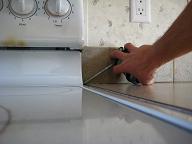 on the insect and cuts through the waxy covering over the exoskeleton. The insecticide can now enter the body or the pest simply dries out. If enough dust covers the bug it will fill the spiracles (air tubes) and the insect dies.
on the insect and cuts through the waxy covering over the exoskeleton. The insecticide can now enter the body or the pest simply dries out. If enough dust covers the bug it will fill the spiracles (air tubes) and the insect dies.
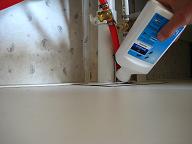 Dusts have a wide range of insects it will kill. Wood roaches, fleas in carpet, American roaches, German cockroaches, Palmetto bugs, Bed bugs, Black widow spiders, Recluse spiders, Earwigs, Crickets, Silverfish, Box elder bugs and the list goes on and on. The trick however is to use the dusts correctly in areas where it won’t become airborne going off target and causing unintended problems. For instance you’ll notice ‘fleas in carpet’ is listed. It’s on some powder labels to use this way and they even make some fancy applicator tools to make it very easy for you to spread the powder all over your carpets. While I agree it works very well, fleas do die but it exposes you and I on a daily basis to the powder. Every time you walk across the floor it get’s stirred up. Would you let your baby crawl on it? For me, I only apply dusts to voids in walls etc. or to spaces behind furniture or areas that will not be disturbed. Also while I’m at it, let me warn you. Dusts and powders in general are flammable. Never dust in fire or near an open flame such as a ‘pilot light’ in a stove. Years ago I found this out and had to walk around for about a month without eyebrows till they grew back. (You’ve been warned)
Dusts have a wide range of insects it will kill. Wood roaches, fleas in carpet, American roaches, German cockroaches, Palmetto bugs, Bed bugs, Black widow spiders, Recluse spiders, Earwigs, Crickets, Silverfish, Box elder bugs and the list goes on and on. The trick however is to use the dusts correctly in areas where it won’t become airborne going off target and causing unintended problems. For instance you’ll notice ‘fleas in carpet’ is listed. It’s on some powder labels to use this way and they even make some fancy applicator tools to make it very easy for you to spread the powder all over your carpets. While I agree it works very well, fleas do die but it exposes you and I on a daily basis to the powder. Every time you walk across the floor it get’s stirred up. Would you let your baby crawl on it? For me, I only apply dusts to voids in walls etc. or to spaces behind furniture or areas that will not be disturbed. Also while I’m at it, let me warn you. Dusts and powders in general are flammable. Never dust in fire or near an open flame such as a ‘pilot light’ in a stove. Years ago I found this out and had to walk around for about a month without eyebrows till they grew back. (You’ve been warned)
All right let’s look at how to dust correctly. First there are many types of dusters but we’ll just deal with 2 since the same basics apply.
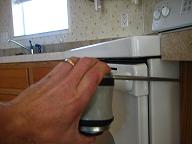 The ‘puff duster’ also known as a ‘bellow’ duster is an awesome tool that everyone who does their own pest control should have. You can get a puff duster from any DIY pest control store. It’s sturdy, versatile and can apply a nice even shot every time. Key points; The duster should be held as if it’s upside down with the applicator tip up, do it the other way and the tip will clog. Never clamp down on the duster with excessive force, this too will force to much out to quick and it will clog even if held correctly.
The ‘puff duster’ also known as a ‘bellow’ duster is an awesome tool that everyone who does their own pest control should have. You can get a puff duster from any DIY pest control store. It’s sturdy, versatile and can apply a nice even shot every time. Key points; The duster should be held as if it’s upside down with the applicator tip up, do it the other way and the tip will clog. Never clamp down on the duster with excessive force, this too will force to much out to quick and it will clog even if held correctly.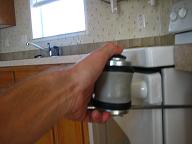 If it does clog however, simply unscrew the tip clean plunger tool from the back and ream out the tip to clear it. (Screw it back BEFORE continuing) Filling the duster is fairly simple. Remove the rubber stopper with a turning motion and pull gently. Today’s dust products such as Delta and Drione have the perfect size opening to fill your duster. Wear at least a dust mask and some gloves in case some gets airborne. (and it will) Only fill your applicator 1/2 to 3/4 full so you have air pushing out as well as dust. Now you’re ready to use your puff duster.
If it does clog however, simply unscrew the tip clean plunger tool from the back and ream out the tip to clear it. (Screw it back BEFORE continuing) Filling the duster is fairly simple. Remove the rubber stopper with a turning motion and pull gently. Today’s dust products such as Delta and Drione have the perfect size opening to fill your duster. Wear at least a dust mask and some gloves in case some gets airborne. (and it will) Only fill your applicator 1/2 to 3/4 full so you have air pushing out as well as dust. Now you’re ready to use your puff duster.
Shelf ready ‘Bottle Duster’; fairly simple to use but remember to remove the protective covering over the mouth of the bottle. The tip is pre cut but if for some reason you need more dust you can cut it for a larger hole. (Don’t cut too much) Mask and gloves apply hear as well. You’re ready to use your ‘Bottle Duster.’
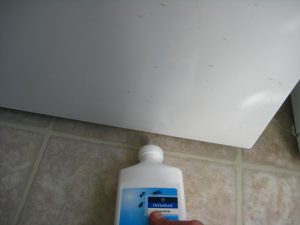 OK lets dust; as stated you can dust so many different places. The trick is never dust to heavily. It’s a waste and it’s now an area the bugs will avoid like the plague. A light puff or two so that you can barely see the powder is perfect. For larger voids you can apply more force to get the dust to cover more fully but not to much more. If treating under appliances hit it from 2 or 3 sides to get your coverage and do the space behind as well. Oh one quick note, refrigerators are not good to dust around, the fans on the compressor will ‘puff’ the dust back at you and into the room every time it clicks on. Boric acid aerosols are better suited for this area and we’ll cover those products in another article. Be creative in as safe a manner as you can and you’ll be able to put a very nice, invisible, long lasting dust barrier in and around your home that will kill unwanted bugs for a long time.
OK lets dust; as stated you can dust so many different places. The trick is never dust to heavily. It’s a waste and it’s now an area the bugs will avoid like the plague. A light puff or two so that you can barely see the powder is perfect. For larger voids you can apply more force to get the dust to cover more fully but not to much more. If treating under appliances hit it from 2 or 3 sides to get your coverage and do the space behind as well. Oh one quick note, refrigerators are not good to dust around, the fans on the compressor will ‘puff’ the dust back at you and into the room every time it clicks on. Boric acid aerosols are better suited for this area and we’ll cover those products in another article. Be creative in as safe a manner as you can and you’ll be able to put a very nice, invisible, long lasting dust barrier in and around your home that will kill unwanted bugs for a long time.




